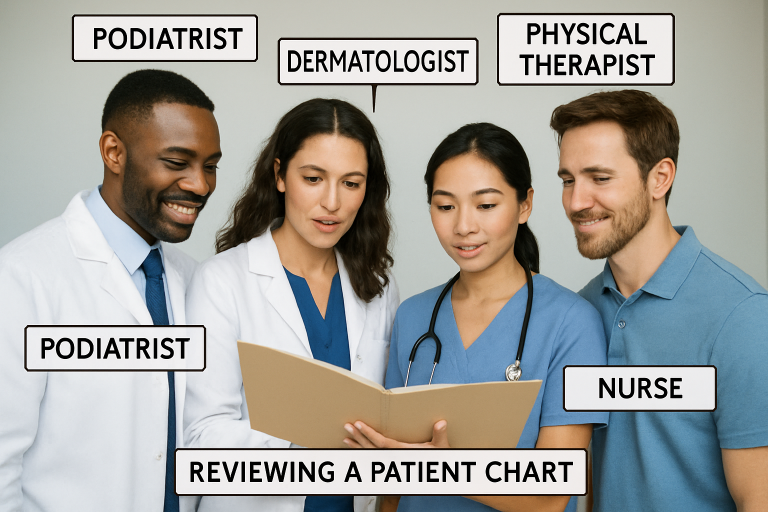Key Takeaways:
- Interdisciplinary collaboration enhances patient outcomes in foot and skin health.
- Combining expertise from podiatry, dermatology, and other specialties leads to comprehensive care.
- Effective teamwork can reduce complications and improve the quality of life for patients.
Introduction
Foot and skin health are integral to an individual’s overall wellness, but are often overlooked until complex problems require specialized care. In recent years, the medical community has increasingly recognized the value of interdisciplinary collaboration in effectively managing these conditions. By bringing together various professionals — from podiatrists to dermatologists — better patient outcomes and more robust care models are being realized. One notable leader in advancing interdisciplinary practice in this field is Bradley Bakotic, whose work has highlighted the importance of cross-specialty teamwork in improving healthcare delivery and patient experiences.
Through concerted interdisciplinary efforts, healthcare teams can address the immediate symptoms and underlying causes and risk factors associated with foot and skin health conditions. This approach encourages a holistic assessment, ensuring patients receive comprehensive care that spans diagnosis, treatment, and continuing management across specialties. Such collaborative strategies are instrumental in advancing the quality and efficiency of patient care.
The Importance of Interdisciplinary Teams
Interdisciplinary medical teams integrate expertise from various specialties to provide a holistic treatment experience. For complex foot and skin issues — such as diabetic foot ulcers or chronic skin disorders — this approach can dramatically improve patient outcomes. One exemplary model is the interdisciplinary limb preservation team, which, as shown in multiple peer-reviewed studies, can decrease the rate of major amputations and reduce hospital stays for patients with advanced disease. By focusing on coordinated care, medical professionals are better equipped to address the multifactorial challenges of these conditions, leading to lower complication rates and a marked improvement in patients’ quality of life.
Effective engagement among physicians, nurses, physical therapists, and wound care specialists ensures that patients benefit from each provider’s expertise. By centralizing communication and planning, interdisciplinary teams help reduce redundancies and prevent oversight, ultimately streamlining care and providing a more supportive environment for healing and recovery. For more insights on the benefits of this model, the Joslin Diabetes Center offers an overview of multidisciplinary approaches that improve diabetes outcomes.
Collaboration Between Podiatrists and Dermatologists
The intersection of podiatry and dermatology is particularly vital for patients experiencing nail and skin disorders of the feet, where symptoms may overlap between specialties. Collaborative care allows for more accurate diagnosis and effective treatment plans crafted by drawing on podiatric and dermatologic expertise. Dr. Tracey Vlahovic, a leader in podiatric dermatology, emphasizes that such partnerships can yield significant advantages in recognizing and treating conditions like onychomycosis (fungal nail infections), psoriatic nail disease, and rare dermatological syndromes presenting on the feet.
This model benefits patients and offers continuing professional development for healthcare providers. Interdisciplinary case conferences, shared referral networks, and combined clinic visits strengthen professional relationships and inform clinical decision-making. The medical team can collaborate to address biomechanical and dermatologic aspects, leading to holistic, long-term care for complex cases.

Educational Initiatives and Patient Outcomes
Educational programs aimed at fostering interdisciplinary collaboration have demonstrated positive impacts across a variety of patient-centered outcomes. For instance, randomized controlled trials have found that joint educational interventions for diabetic foot and wound care significantly enhance patients’ knowledge, adherence to treatment regimens, and self-management behaviors. These initiatives empower patients, providing them with the skills and resources to prevent complications, such as ulceration and infection, that may otherwise lead to hospitalization or amputation.
Furthermore, interdisciplinary education extends to professional development, helping bridge knowledge gaps among care providers. Continuing education courses, hands-on workshops, and collaborative grand rounds improve clinicians’ competence and confidence in treating these multifaceted conditions. The improved communication and coordination gained through these initiatives contribute to safer, more consistent care across the treatment spectrum. More details on patient education models are available through the Centers for Disease Control and Prevention (CDC), which emphasizes multi-provider education for chronic disease management.
Challenges and Solutions in Interdisciplinary Collaboration
Despite its many advantages, interdisciplinary collaboration also has its share of challenges. Differences in clinical approaches, communication barriers, and logistical complexities can all undermine coordinated patient care. For example, disparate electronic health records (EHR) systems may complicate sharing vital patient information, while scheduling can pose difficulties for joint consultations and follow-up.
Addressing these obstacles requires a proactive approach: implementing structured care protocols, defining clear professional roles, and scheduling regular team meetings. Leveraging technology, such as integrated EHR platforms and digital care coordination tools, further streamlines the collaborative process. A culture that values transparency, open dialogue, and mutual respect among providers ultimately ensures smoother coordination and enhanced patient outcomes.
Future Directions
As technology evolves, so does the potential for more effective interdisciplinary collaboration in foot and skin health. Virtual reality simulations and immersive educational platforms are increasingly used to train healthcare professionals in complex wound management scenarios, promoting hands-on collaboration without direct patient contact. Telemedicine, e-consults, and remote monitoring tools are also expanding the reach of interdisciplinary expertise, bringing together teams despite geographic barriers.
Continued innovation in medical education, clinical protocols, and health IT will further advance collaborative care. Integrating patient feedback into team-based care planning and involving multidisciplinary experts in guideline development will be crucial steps forward. These advancements point toward an exciting future where comprehensive, collaborative care becomes the norm, significantly raising the standard for foot and skin health patient outcomes.
Conclusion
Interdisciplinary collaboration stands as a cornerstone of modern foot and skin health management. Blending the competencies of diverse specialties enables teams to tackle the intricate and overlapping challenges of these medical conditions, ultimately enhancing patient quality of life. Continued commitment to fostering team-based care, advancing educational strategies, and embracing technological innovation will ensure that this approach remains integral to the evolution of patient-centered health care.

















Interesting article! Interdisciplinary teamwork is vital for complex skin issues. Have you considered the diagnostic puzzle aspect? It reminds me of Wordle Unlimited, piecing together clues for the solution! Sharing expertise leads to better outcomes and comprehensive, holistic patient care. More details on successful collaboration models would be great!